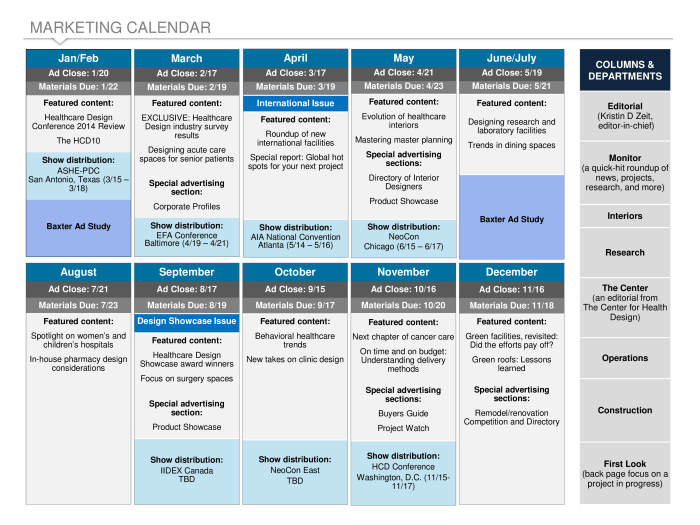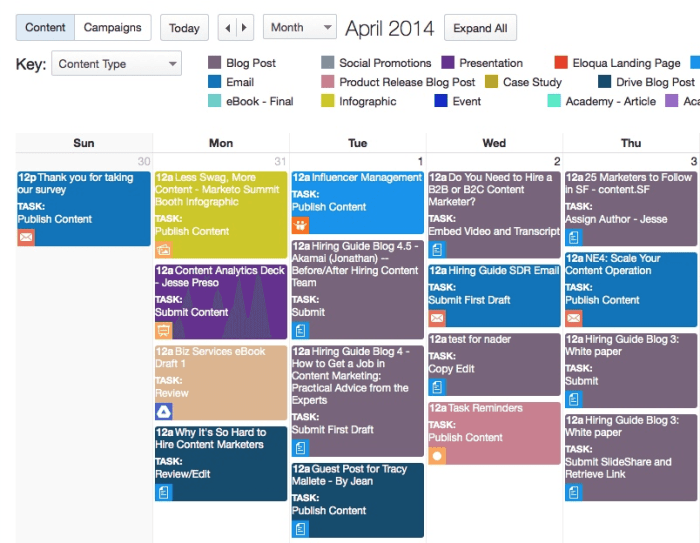Creating a Content Marketing Calendar dives into the essential tool for businesses to streamline their marketing efforts, ensuring consistency and efficiency in reaching their target audience. Buckle up for a ride through the world of content organization and planning!
In this guide, we’ll explore the key components, creation process, collaboration strategies, and monitoring techniques for a successful content marketing calendar.
Importance of a Content Marketing Calendar
In the fast-paced world of digital marketing, having a content marketing calendar is absolutely essential for businesses looking to stay ahead of the game. A content calendar serves as a roadmap for your marketing efforts, helping you stay organized, plan ahead, and maintain consistency in your messaging.
Organizing and Planning Marketing Efforts
By creating a content calendar, businesses can strategically map out their content for weeks or even months in advance. This allows for better coordination between different departments, ensures that content aligns with business goals, and helps in scheduling campaigns to coincide with important events or seasons.
- Keeps track of important dates and deadlines
- Assists in allocating resources effectively
- Enables better collaboration among team members
A well-planned content calendar can prevent last-minute scrambles and ensure that your messaging is consistent across all platforms.
Benefits of Using a Content Calendar
Using a content calendar brings a multitude of benefits to businesses, including increased efficiency and improved results in their marketing efforts.
- Consistency: By scheduling content in advance, businesses can maintain a consistent posting schedule, which helps in building brand awareness and engaging with their audience regularly.
- Efficiency: Planning content ahead of time saves valuable resources, reduces stress, and allows for more strategic and thoughtful content creation.
- Analysis and Optimization: With a content calendar, businesses can track the performance of their content, analyze what works best, and make data-driven decisions to optimize future campaigns.
Components of a Content Marketing Calendar
Creating a successful content marketing calendar involves key elements that help in planning, organizing, and executing your content strategy effectively. By including the right components, you can ensure consistency, relevance, and engagement with your target audience.
Timelines
Timelines are crucial in a content marketing calendar as they help you schedule when each piece of content will be published. This ensures that you have a steady stream of content going out to your audience, keeping them engaged and informed. By setting deadlines for content creation, review, and publication, you can maintain a consistent presence across your channels.
Content Types
Another important component of a content marketing calendar is the inclusion of different content types. This can include blog posts, videos, infographics, social media posts, podcasts, and more. By diversifying your content types, you can appeal to a wider range of audience preferences and keep your content strategy fresh and engaging.
Channels
Incorporating the channels through which your content will be distributed is key to a successful content marketing calendar. Whether it’s your website, social media platforms, email newsletters, or other distribution channels, outlining where each piece of content will be shared ensures maximum visibility and reach. Tailoring your content to fit each channel’s unique requirements can enhance its impact and effectiveness.
Categorization
Organizing your content based on themes, goals, or target audience is essential for a well-rounded content marketing calendar. By categorizing your content, you can align it with your overall marketing objectives, ensure relevance to your audience, and track the performance of each content category. This allows for more targeted and strategic content creation that resonates with your audience and drives desired outcomes.
Creating a Content Calendar
Creating a content calendar is essential for organizing your content marketing strategy and ensuring that you stay consistent with your efforts. Here is a step-by-step guide on how to create a content marketing calendar:
Setting Realistic Deadlines and Milestones, Creating a Content Marketing Calendar
Setting realistic deadlines and milestones in your content calendar is crucial for staying on track and meeting your content goals. Here are some tips to help you set realistic deadlines and milestones:
- Break down larger projects into smaller tasks with specific deadlines.
- Consider factors like research time, content creation, editing, and publishing when setting deadlines.
- Allocate buffer time for unexpected delays or revisions.
- Regularly review and adjust deadlines based on your progress and priorities.
Remember, it’s better to underpromise and overdeliver than to set unrealistic deadlines and fall short.
Tools and Software for Content Calendar Management
There are various tools and software available to help you create and manage your content calendar effectively. Here are some popular options:
| Tool | Description |
|---|---|
| Google Calendar | Free and easy-to-use calendar tool for scheduling and organizing content. |
| Trello | Visual project management tool for creating content calendars and assigning tasks. |
| Asana | Collaborative work management platform for planning and tracking content projects. |
By following these steps and utilizing the right tools, you can create a content calendar that helps you stay organized, consistent, and on track with your content marketing efforts.
Content Planning and Scheduling

To ensure a successful content marketing strategy, it is crucial to have a well-thought-out plan for creating and scheduling content. This involves brainstorming ideas that align with your marketing goals, strategically planning publication dates, and finding a balance between evergreen content and trending topics.
Brainstorming Content Ideas
When brainstorming content ideas, start by identifying your target audience and understanding their needs and interests. Consider how you can provide value to them through your content. Brainstorming sessions with your team can help generate creative ideas that align with your brand messaging and marketing objectives.
- Utilize tools like research, social media trends, and competitor analysis to gather inspiration for content ideas.
- Consider creating a content calendar with themes or topics for each month to ensure a cohesive and consistent approach.
- Encourage collaboration among team members to bring diverse perspectives and ideas to the table.
Scheduling Content Publication Dates
Once you have a list of content ideas, it’s essential to schedule publication dates strategically to maximize impact and reach. Consider factors like seasonality, holidays, industry events, and your target audience’s behavior to determine the best times to publish your content.
- Use a content calendar tool to organize and schedule your content in advance, ensuring a consistent posting schedule.
- Experiment with different posting times and days to identify when your audience is most active and engaged.
- Consider repurposing and updating evergreen content to keep it relevant and valuable to your audience over time.
Balancing Evergreen Content and Trending Topics
Finding the right balance between evergreen content that provides long-term value and trending topics that capitalize on current interests is key to a successful content marketing strategy. Incorporate both types of content into your calendar to maintain relevance and appeal to a wide range of audience interests.
Remember to regularly review and update your content calendar to adapt to changing trends and audience preferences.
Collaboration and Team Involvement
Collaboration between team members is crucial in creating a successful content calendar. When everyone works together towards a common goal, it ensures that the content strategy is cohesive, consistent, and aligned with the overall brand message.
Assigning Responsibilities and Tasks
Assigning responsibilities and tasks within the content calendar is essential for ensuring that everything gets done on time and according to plan. Here are some tips for effectively assigning responsibilities:
- Identify team members’ strengths and expertise to assign tasks that play to their skills.
- Clearly define roles and responsibilities for each team member to avoid confusion.
- Set deadlines and milestones to track progress and ensure accountability.
- Regularly communicate with team members to provide updates and address any challenges that may arise.
Fostering Communication and Feedback
Fostering open communication and feedback among team members is key to a successful content strategy. Here are some tips to encourage communication and feedback:
- Hold regular team meetings to discuss progress, brainstorm ideas, and address any issues.
- Use project management tools to collaborate on content creation, track changes, and provide feedback in real-time.
- Encourage team members to share their ideas, feedback, and suggestions openly to improve the overall content strategy.
- Provide constructive feedback and recognize team members’ contributions to boost morale and motivation.
Monitoring and Adjusting the Content Calendar: Creating A Content Marketing Calendar

Monitoring and adjusting the content calendar is crucial for ensuring that your content marketing efforts are effective and aligned with your goals. By tracking performance and making adjustments based on analytics and feedback, you can continuously improve your content strategy.
Significance of Monitoring Content Performance
Monitoring content performance against set goals allows you to measure the success of your content marketing efforts. It helps you understand what is working well and what areas need improvement. By analyzing key metrics such as website traffic, engagement rates, conversion rates, and social media metrics, you can gain valuable insights into the effectiveness of your content.
- Track key performance indicators (KPIs) to measure the success of your content.
- Identify trends and patterns in content performance to inform future content creation.
- Adjust your content strategy based on data to optimize results and achieve your goals.
Ways to Track and Analyze Content Effectiveness
There are various tools and techniques you can use to track and analyze the effectiveness of content on your calendar. Utilize analytics platforms like Google Analytics, social media insights, and email marketing tools to gather data on how your content is performing. Conduct A/B testing, surveys, and user feedback to gather qualitative insights.
Utilize data-driven insights to make informed decisions about your content strategy.
Techniques for Adjusting the Content Calendar
Adjusting the content calendar based on analytics and feedback is essential for continuous improvement. Use the insights gathered from monitoring content performance to make data-driven decisions about what content to create, when to publish, and how to optimize for better results. Experiment with different types of content, formats, and distribution channels to see what resonates best with your audience.
- Regularly review and analyze content performance data to identify areas for improvement.
- Implement changes to your content calendar based on insights to optimize performance.
- Continuously test and refine your content strategy to achieve better results over time.